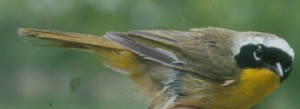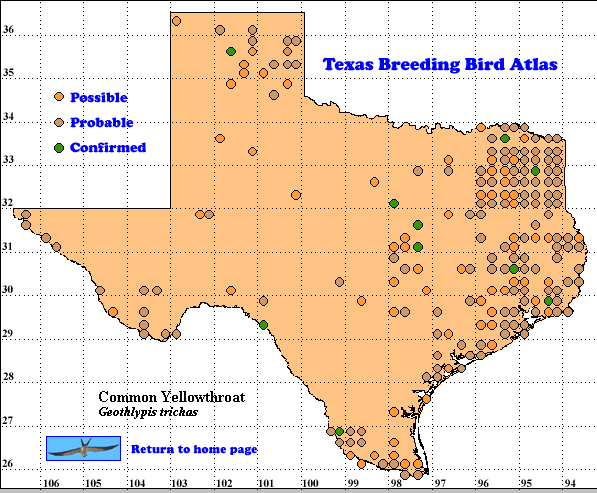Common Yellowthroat is almost synonymous with dense shoreline vegetation such as cattails. The species has declined in many areas as wetlands have been filled or drained in the earlier years, but recent trend data suggest populations in the United States and Canada are relatively stable.
The species is sexually dimorphic; the male with a black mask is easily identified, while the plainer female lacks this distinctive mark. Subspecies taxonomy is confusing (Pyle 1997, Guzy and Ritchison 1999).
DISTRIBUTION. During the 1987-1992 field work for the TBBA project atlasers found the densest concentration of breeding sites for Common Yellowthroat in the Pineywoods region, along the Gulf Coast, and in the lower Rio Grande valley. Nesting was also found in the northern Panhandle and along the Rio Grande River from Del Rio to El Paso. More scattered breeding was also noted from the 96th meridian west to the 98th meridian.
In winter Common Yellowthroats are found primarily on the Coastal Prairies and across the southern half of the state (Lockwood and Freeman 2004).
Elsewhere the species breeds across Canada from the Northwest Territories to Newfoundland and south through the lower elevations in the United States. to the Gulf coast. In Mexico Common Yellowthroat breeds in the highlands south to the Isthmus of Tehuantepec and in northern Baja California.
After breeding northern populations move south to winter on the Atlantic and Gulf coastal plains from Virginia south and along the Pacific coast from San Francisco to Cabo San Lucas, Baja California Sur. The species winters throughout mainland Mexico and Central America south to central Panama and also in Bermuda, the Bahamas, Caymans and Greater Antilles (Howell and Webb 1995; Guzy and Ritchison 1999).
SEASONAL OCCURRENCE. Determining arrival and departure dates for the Common Yellowthroat in Texas is difficult because some individuals are present in the state at any time of the year. Most birds appear to arrive between mid-March and mid-May. The species breeds from early April to mid-July, occasionally to late September. Eggs have been found from April 9 to June 29; TBBA observers found a pair on a nest May 4 and recently fledged young at another site that month. Nestlings were found as late as September 20. Most southbound Common Yellowthroats move through Texas between early September and late October (Oberholser 1974, Lockwood and Freeman 2004).
BREEDING HABITAT. In Texas Common Yellowthroats breed from sea level to 1200 m (4000 ft) in dense vegetation such as cattails in fresh or salt water marshes, swamps and ponds. The nest, built by the female, is usually a bulky, loosely constructed open cup, sometimes globular or domed with a side entrance, and often concealed in vegetation. It is tightly lodged in supporting vegetation and is composed of coarse grasses, reed shreds, leaves, strips of bark, mosses, sedges, ferns, small twigs and lined with finer grasses, rootlets, bark fiber and animal hair. The outside diameter and height are 8 cm (3 in); inside diameter and cup depth are 4.5 cm (1.8 in).
The female lays 4 (range 3-6) white to cream white eggs, which she incubates for 12 (range 11-13) days. The nestlings leave the nest at about 12 days after hatching. When a second brood is planned, the female feeds the fledgling for several days, and then the male feeds them. The rate of parasitism by Brown-headed Cowbird (Molothrus ater) is relatively low (Oberholser 1974, Harrison 1979, Guzy and Ritchison 1999).
STATUS. Because the preferred breeding sites of Common Yellowthroat are often small and irregularly distributed, abundance is difficult to characterize. In this context Lockwood and Freeman’s (2004) description of the breeding density of this species in the northeast part of the state as “rare to locally common” is very appropriate.
Although the TBBA map does not differ significantly from that of Oberholser (1974), North American Breeding Bird Survey (BBS) data from 1994-2003 indicate Common Yellowthroat is less abundant in Texas than Oberholser’s estimate in 1974. The area of highest abundance currently is in the extreme northeast corner where BBS participants found an average of 3-10 yellowthroats per 40 km (25 mi) BBS route. Further south along the Louisiana border and the northern Gulf Coast, density dropped to 1-3 individuals per route. In the remaining areas of Texas where TBBA workers found breeding evidence for this species, BBS data report a density of <1 yellowthroat per route (Sauer et al. 2004).
Common Yellowthroats in migration are fairly common to uncommon through the state. In winter the species is uncommon to locally common in much of the southern half of Texas, but generally rare to locally uncommon in the Trans-Pecos region (Lockwood and Freeman 2004).
BBS observers detected Common Yellowthroat on 35 routes in Texas. The data obtained produced a 95% confidence interval for the period 1966-2003 of -3.5 to 6.9 percent population change per year (There are 19 chances out of 20 that the actual trend will fall between these two figures). The larger sample of 2912 routes recording this species across the United States and Canada produced a statistically significant trend of -0.3% (Sauer et al. 2004).
The future of Common Yellowthroat as a breeding species in Texas is obviously dependent on the fate of its limited breeding sites. The fate of the species as a migrant and winter visitor is more promising since habitat used in these seasons is not so limited. Text by Robert C. Tweit (2004)
Literature cited:
Guzy, M. J. and G. Ritchison. 1999. Common Yellowthroat (Geothlypis trichas). In The birds of North America, No. 448 (A. Poole and F. Gill, eds.). The Birds of North America, Inc., Philadelphia, PA.
Harrison, H. H. 1979. A field guide to western birds’ nests. Houghton Mifflin, Boston, MA.
Howell, S. N. G. and S. Webb. 1995. A guide to the birds of Mexico and northern Central America. Oxford University Press, New York.
Lockwood, M. W. and B. Freeman. 2004. The TOS handbook of Texas birds. Texas A&M University Press, College Station.
Oberholser, H. C. 1974. The bird life of Texas. University of Texas Press, Austin.
Pyle, P. 1997. Identification guide to North American birds, part 1. Slate Creek Press, Bolinas, CA.
Sauer, J. R., J. E. Hines, and J. Fallon. 2004. The North American Breeding Bird Survey, results and analysis 1966-2003. Version 2004.1. USGS Patuxent Wildlife Research Center, Laurel MD (Web site, http://www.mbr-pwrc.usgs.gov/bbs).

